Miami University geology research has far reach, local implications
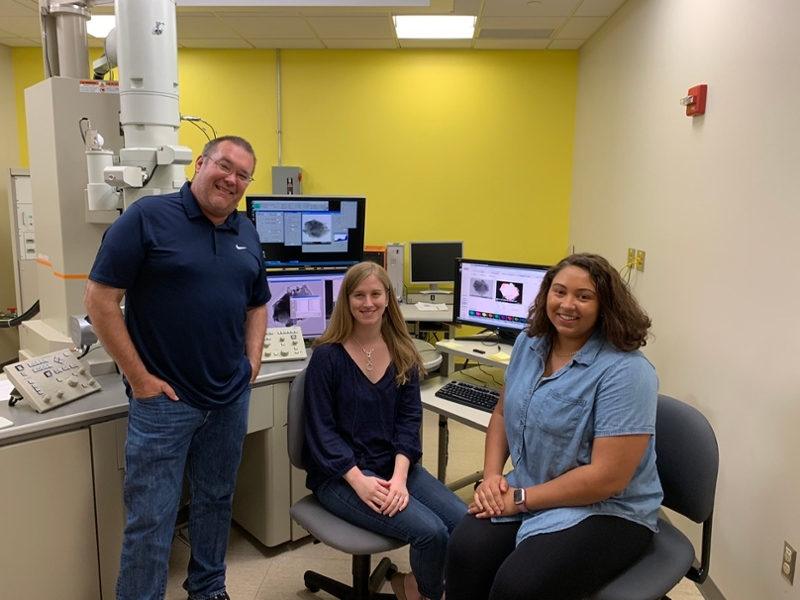

Written by Mary C. Dillon, Marketing & Communications
For most faculty, getting their research published in peer-reviewed journals is career gold.
It’s safe to say in 2020 alone, Miami University Regionals Associate Professor of Geology Dr. Mark Krekeler has the golden touch.
Working alongside his students and colleagues from Miami University’s Oxford campus, Krekeler had eight papers published or accepted into noted environmental journals in 2020. The research may have been done in places like Pennsylvania, Nevada, Idaho and Algeria, but its impact can be felt across the region.

Mark Krekeler with recent Ph.D. student Brittany Cymes and Undergrad Angela Arrington.
Is yellow traffic paint safe?
Pollution from heavy metals in urban environments has been linked to inhibited neurological development and could have toxic effects on many organs. Two such metals -- lead and chromium -- are found in crocoite, the pigment that makes up yellow traffic paint.
Krekeler and his team, which included researchers from the University of Pennsylvania, collected samples of YTP along Philadelphia’s 41st Street at three separate points between Pine and Spruce streets. The samples were then mixed with rainwater and simulated gastric fluid in an effort to see how dangerous these particles would be if ingested by humans.
"While still toxic, our findings showed that the coated crocoite particles in YTP are probably less dangerous than initially believed," said Krekeler. "Earlier versions of YTP were uncoated; new versions, however, are coated by paint polymers that prevent the crystals from dissolving. That buffer helps to limit the release of lead and chromium by trapping them."
The research, which appears in "Science of The Total Environment," noted that additional testing is required to know under what conditions and when these crystals may ultimately break down.
Student involvement is key
Krekeler is quick to point out that he doesn’t work in a vacuum.
"My colleagues and I have a strategic team approach where undergraduates that are interested in research are identified in classes or through activities such as our National Science Foundation GEOPATHS-funded undergraduate career development program. Then through working with other team members, such as graduate students, staff and other faculty, we create meaningful opportunities,” Krekeler said. "Graduate students learn to develop complex projects, mentor, organize and contribute as undergraduates build lab, field work and writing."
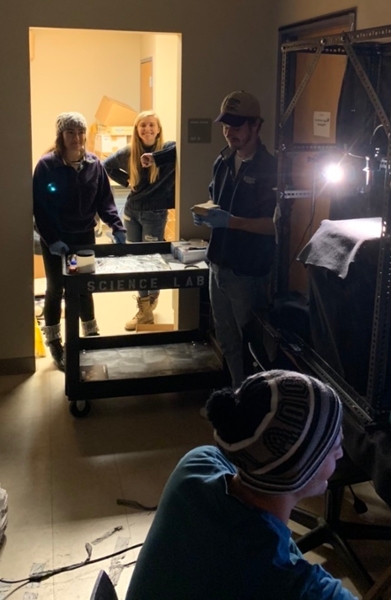
Jordan Vest, Claudia Dawson, Traister Oglesbee and Carter Lindeman working with a spectroradiometer at the Miami University Hamilton Campus.
"We have been lucky in having two staff members funded by the Department of Justice that have amplified our work as well," Krekeler added. "All of these efforts develop an environment where we closely support each other and make our success a habit."
Krekeler and his Oxford colleague, Dr. Claire McLeod, assistant professor of geology, are committed to fostering undergraduate research. Five Miami Regionals students and alumni have shared authorship with them this year. Junior Traister Oglesbee from Oxford is on two of the papers.
In June, Krekeler and McLeod teamed up with Oglesbee and Carter Lindeman from Fairfield on published research to evaluate silica sources for solar cell production, which looks at the use of gold and rare earth by-products, components essential for a "green economy."
The Kinnikinic Quartzite is an extensive formation of distinctive white cliffs of quartzite that reach across east-central Idaho. The team tested samples from the formation in an effort to help them make an informed decision on the viability of locating a plasma furnace processing plant in the region. These high-temperature furnaces have the potential to take mining waste and convert it into energy producing resources.
The study found that concentrations of gold and silica in the samples were at or below expected levels. They recommended that broader, more regionally oriented testing be done to determine the viability of the processing plant.
According to Krekeler, the same approach could potentially be used with the region’s extensive sand and gravel industry but in different ways. There are several waste streams in Ohio in different industries that could be investigated.
"While the research took place in Idaho, it affects Ohio and neighboring states because rare earth elements are critical to the emerging green economy as well as many well-established consumer products," Krekeler said. "Identifying new sources is critical for long-term economic growth."
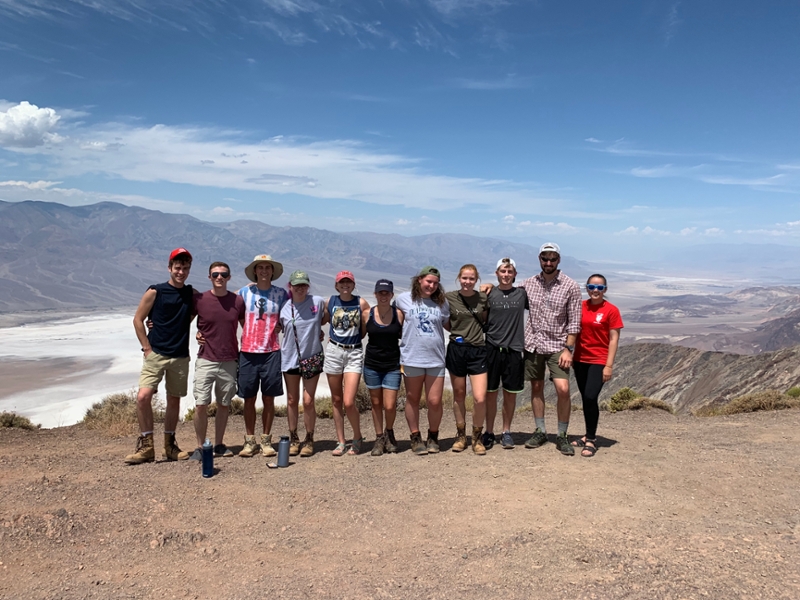
AUGITE group on field trip to Death Valley.
Oglesbee joined Aurora, Illinois, native Jordan Vest on another project that studied the sand dunes in Tonopah, Nevada, a town with a long history of silver mining. The project -- the first of its kind -- noted that the dunes are similar to those found in the Mojave Desert dune fields but are distinct from those found in the Algodones and Parker dunes of California and Arizona, respectively.
Krekeler said once the characteristics of these landscapes are established, "they can be used as reference materials in environmentally focused research and pollution studies in Nevada for years to come."
Krekeler also joined scientists from Badji Mokhtar University in Algeria and the University of Cardiff in the United Kingdom in a study that looked at Algeria’s ooidal ironstone formations as a potential source of rare earth elements. He and McLeod previously partnered with alums Matt Barnes '15 and Olivia Faraci '19 on a five-year peer-reviewed study of glacial sediments in Butler County.
More to come
If 2020 wasn’t enough, stay tuned. Students involved with Krekeler and McLeod have more to come in 2021.
Up first is junior Ethan Klein. The Stevenson Ranch, CA, native has research slated for publication on the toxicity of talc ore, sampled at Willow Creek Mine in Montana.
Dr. Krekeler, Dr. McLeod and their students plan on presenting virtually in the spring of 2021 at Geological Society of America regional meetings on these and several new projects in the areas of asbestos, talc deposits, urban pollution and economic geology.
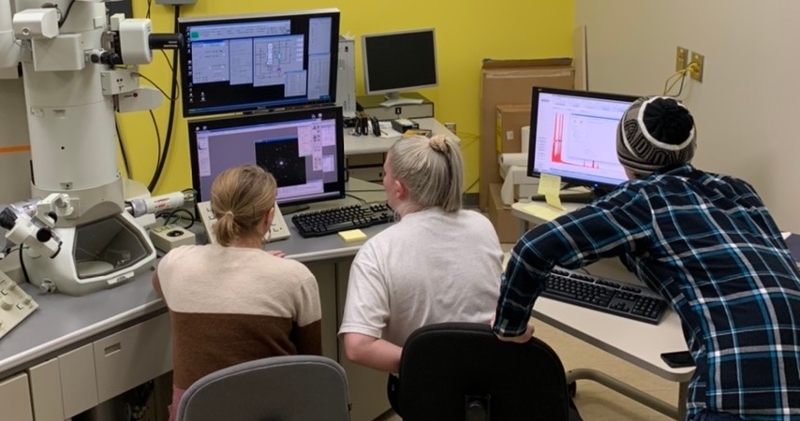
Grad student Sarah Wayman, Lauren Doepke, Carter Lindeman working on the transmission electron microscope.
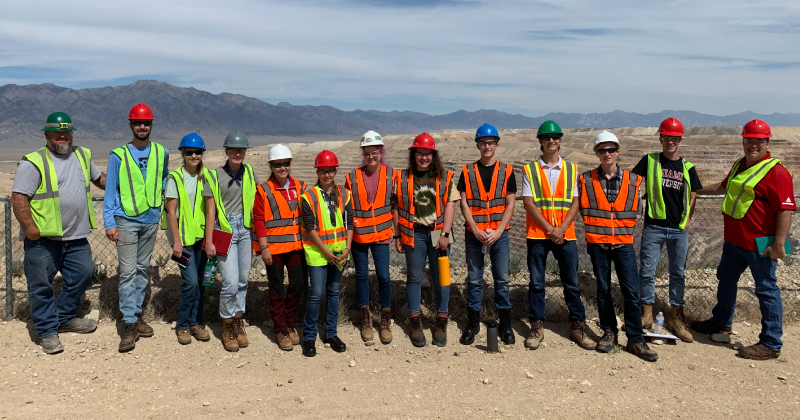
AUGITE students at Round Mountain Gold Mine.

